Treatment for Alzheimer found effective in preventing inflammation in orthopedic implants
2021-05-11
(Press-News.org) Dental and orthopedic implants are widely used around the world. Common causes for implant failure are the immune response against oral bacteria and titanium particles shed by the implant. These and other phenomena can generate an inflammatory response, activating the osteoclasts (bone resorbing cells), and ultimately leading to osteolysis (destruction of bone tissue) around the implants. After this process begins, it is almost impossible to control, eventually leading to loss of the implant. A similar process occurs around natural teeth, with bacteria as the main cause, and bone resorption triggered by the immune response and inflammatory cells.
Researchers from Tel Aviv University have developed an active molecule (SNV) derived from a vasoactive intestinal peptide (VIP, a short protein), which can significantly suppress both the inflammation and the resulting bone destruction. The new technology can help people with orthopedic implants, following, for example, knee implantations, people with dental implants, and people suffering from gum recession (which is in fact bone resorption) or loose teeth, as a result of gum (periodontal) disease. VIP acts as a neurohormone and neurotransmitter related to many physiological processes, such as expanding blood vessels, expanding respiratory passages, cell division and nerve protection. The researchers attached a lipid to the protein making it "fatty" to enable its penetration through the skin, to facilitate administration as an ointment.
The study, conducted by Prof. Yankel Gabet, Prof. David Kohavi, Prof. Illana Gozes, Dr. David Dangoor and Dr. Michal Eger from TAU's Sackler Faculty of Medicine was just published in Frontiers in Pharmacology. The paper also presents preparations for a clinical trial and results regarding SNV's penetration through the skin.
"I recently met friends and relatives who had undergone knee or tooth implantations, and I understand the great need of patients for such medications. I hope we can help them," says Prof. Illana Gozes. "For years I have worked on VIP - the important protein hormone that maintains the viability of brain cells and also plays a part in sexual activity. We were first in the world to isolate the VIP gene, at a time when genetic cloning was in its infancy. We were also first to develop drug candidates by binding VIP with a lipid to create SNV - a molecule that can penetrate the skin and serve as an ointment drug. At that time, we tried to apply the molecule to problems of impotence and Alzheimer's disease, in collaboration with Prof. Mati Fridkin of the Weizmann Institute. Recently I came upon a totally different direction, in which we discovered that SNV is effective for protecting bones against inflammatory processes triggering bone resorption."
To begin with, the researchers tested the molecule's effect on both bone cells and immune cells. At this stage they discovered that metal particles originating from the implants cause accelerated bone resorption. Testing the molecule in an animal model, they were astounded to find that in the presence of SNV the resorption process is largely suppressed. Thus, the drug may repress or even prevent bone resorption, thereby preserving the hold of implants and teeth in the surrounding bone tissue. "These results were achieved thanks to the collaboration between clinicians and researchers, enabling a research-based response to the clinical challenge," explains Dr. Michal Eger, from the Maurice and Gabriela Goldschleger School of Dental Medicine.
Prof. Yankel Gabet concludes: "This project is a classic example of collaboration between different departments at TAU's Faculty of Medicine. On the one hand, together with Prof. David Kohavi, my group has for years studied the connection between the immune system, inflammatory response, and bone cells. On the other, Dr. Michal Eger is a dentist who decided to explore these processes for her doctoral thesis. She attended a course given by Prof. Gozes, in which VIP and SNV were discussed, and an in-depth conversation led to the idea of checking whether these molecules can prevent bone loss around implants and natural teeth. We quickly discovered the enormous potential of SNV for people who suffer from bone loss around teeth and implants. Currently we are working on translating this new discovery to the clinic."
INFORMATION:
[Attachments] See images for this press release:

ELSE PRESS RELEASES FROM THIS DATE:
2021-05-11
LAWRENCE -- The COVID-19 pandemic has presented a new world of challenges for education. But a new study from the University of Kansas shows the voices and experiences of students who are already among the most marginalized can help lead the way in making young people's strengths the focus of education.
Students with disabilities already faced a disproportionate amount of inequities in the American educational system before the pandemic. Researchers interviewed students in this population about their experiences during the pandemic and found that students relied on their own strengths, resilience and self-determination. The findings not only highlight the importance ...
2021-05-11
Extreme weather is harming UK agriculture - but many farmers have not yet made adapting to the effects of the climate emergency a priority, a new study shows.
All farmers who took part in the research said they had experienced or witnessed issues caused by extreme weather such as heavy rain or prolonged dry spells in recent years, and expected these to intensify further.
Many were concerned about the impact of heat and drought on crop and grass growth, with knock-on impacts for yield and winter animal feed, and the implications of heavy rainfall/flooding for soil run-off and erosion and for field operations such as drilling and harvesting. ...
2021-05-11
Greater Presence of Family Physicians, Midwives May Be Key Component to Decreasing Cesarean Delivery Rates
Surgical cesarean births can expose new mothers to a range of health complications, including infection, blood clots and hemorrhage. As part of Healthy People 2020 and other maternal health objectives, the state of California exerted pressure to reduce cesarean deliveries, and statewide organizations established quality initiatives in partnership with those goals. In this study, researchers from Stanford University and the University of Chicago examined unit culture and provider mix differences on hospital and delivery units to identify characteristics of units that successfully reduced their cesarean delivery rates. The mixed-methods study surveyed ...
2021-05-11
SALT LAKE CITY - Today in Nature Communications, researchers at Huntsman Cancer Institute at the University of Utah report critical new insights into how cells mount an attack against melanoma tumors.
Melanoma is an aggressive type of skin cancer that can arise from excess exposure to sun, frequent sunburns, genetics, and other environmental factors. Melanoma, like all cancers, begins within cells. Specially designed and refined over billions of years, cells are experts at working to root out and fix routine errors that arise. A tumor begins when a cell makes faulty copies of itself over and over again. If left unchecked, these faulty cell copies ...
2021-05-11
A new Dartmouth Engineering study shows that integrating renewable energy into the American Electric Power System (AEPS) would enhance the grid's resilience, meaning a highly resilient and decarbonized energy system is possible. The researchers' analysis is based upon the incremental incorporation of architectural changes that would be required to integrate renewable energy into AEPS.
The paper, "A Hetero-functional Graph Resilience Analysis of the Future American Electric Power System," was recently published by IEEE Access.
"We concluded that there are no structural trade-offs between grid sustainability and resilience enhancements, meaning these strategic goals can be pursued ...
2021-05-11
A biochemical reaction between an enzyme called luciferase and oxygen causes fireflies to glow and is considered one of the most well-known examples of bioluminescence in nature. Now, an international team of researchers led by Elena Goun at the University of Missouri is working to harness the power of bioluminescence in a low-cost, noninvasive portable medical imaging device that could one day be applied to many uses in biomedical research, translational medicine and clinical diagnoses.
Potential uses include developing better treatments for cancer, diabetes and infectious diseases, along with monitoring various metabolic functions, such as gut health, in both animals ...
2021-05-11
A University of Alberta virology lab has uncovered how an oral antiviral drug works to attack the SARS-CoV-2 virus, in findings published May 10 in the Journal of Biological Chemistry.
The researchers demonstrated the underlying mechanism of action by which the antiviral drug molnupiravir changes the viral genome, a process known as excessive mutagenesis or “error catastrophe.”
“The polymerase, or replication engine of the virus, mistakes molnupiravir molecules for the natural building blocks required for viral genome replication and mixes them in,” ...
2021-05-11
Ann Arbor, May 11, 2021 - Social isolation among older adults is associated with poor health and premature mortality, but the connection between social isolation and physical functioning is poorly understood. New research generates more robust evidence about the associations between social isolation and physical functioning and how this accelerates over time, reports the American Journal of Preventive Medicine, published by Elsevier. It also highlights the importance of incorporating strategies to reduce social isolation and promote successful aging.
"Physical functioning is understood to influence the health of individuals. And social isolation is prevalent among older adults," ...
2021-05-11
Researchers at UC Santa Cruz have developed a novel chip-based antigen test that can provide ultrasensitive detection of SARS-CoV-2 and influenza A, the viruses that cause COVID-19 and flu, respectively.
The test is sensitive enough to detect and identify individual viral antigens one by one in nasal swab samples. This ultrasensitive technique could eventually be developed as a molecular diagnostic tool for point-of-care use. The researchers reported their findings in a paper published May 4 in Proceedings of the National Academy of Sciences.
"This is a chip-based biosensor capable of detecting individual proteins one ...
2021-05-11
Rheumatic heart disease (RHD) remains a major cause of cardiovascular disease in Africa, even as acute rheumatic fever and RHD have become rare in high-income countries. In a new study led by investigators at Brigham and Women's Hospital, the team modeled the investment case for control of RHD in the African Union (AU) region. Results showed the potential to reduce RHD death by almost a third by increasing coverage of RHD interventions in regions of the AU to 2030, with a high return on investment in both the long and short term. Their results are published in The Lancet Global Health.
"Investing in early detection of rheumatic fever and rheumatic heart disease and providing cardiac surgery to those who need it ...
LAST 30 PRESS RELEASES:
[Press-News.org] Treatment for Alzheimer found effective in preventing inflammation in orthopedic implants



